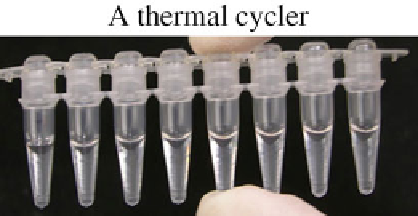Agriculture Reference
In-Depth Information
(continued)
Instrument
Feature
Image
PCR unit
One of the major tools in molecular biology is the PCR. The
polymerase
chain reaction
(PCR) unit is used to amplify a single or a few copies of a
piece of DNA across several orders of magnitude, generating thousands to
millions of copies of a particular DNA sequence. PCR is now a common
and often indispensible technique used in medical and biological research
labs for DNA cloning for sequencing, diagnosis of hereditary diseases,
identification of genetic fingerprints (in forensic sciences and paternity
testing), detection and diagnosis of infectious diseases, etc. A basic PCR
setup requires several components and reagents like DNA template, two
primers, Taq polymerase deoxynucleoside triphosphates, buffer solution,
divalent cations, and monovalent cation. The researchers must be careful
because PCR can fail for various reasons, in part due to its sensitivity to
contamination causing amplification of spurious DNA products. According
to the variations on the basic PCR technique, it can be allele-specific PCR,
asymmetric PCR, dial-out PCR, hot start PCR, intersequence-specific PCR
(ISSR), inverse PCR, ligation-mediated PCR, methylation-specific PCR,
miniprimer PCR, multiplex ligation-dependent probe amplification
(MLPA), multiplex PCR, nested PCR, overlap extension PCR, splicing by
overlap extension (SOE), quantitative PCR (qPCR), reverse transcription
PCR (RT-PCR), solid phase PCR, thermal asymmetric interlaced PCR
(TAIL-PCR), touchdown PCR (step-down PCR), PAN-AC, universal fast
walking, and in silico PCR (digital PCR, virtual PCR, electronic PCR, e-
PCR)






